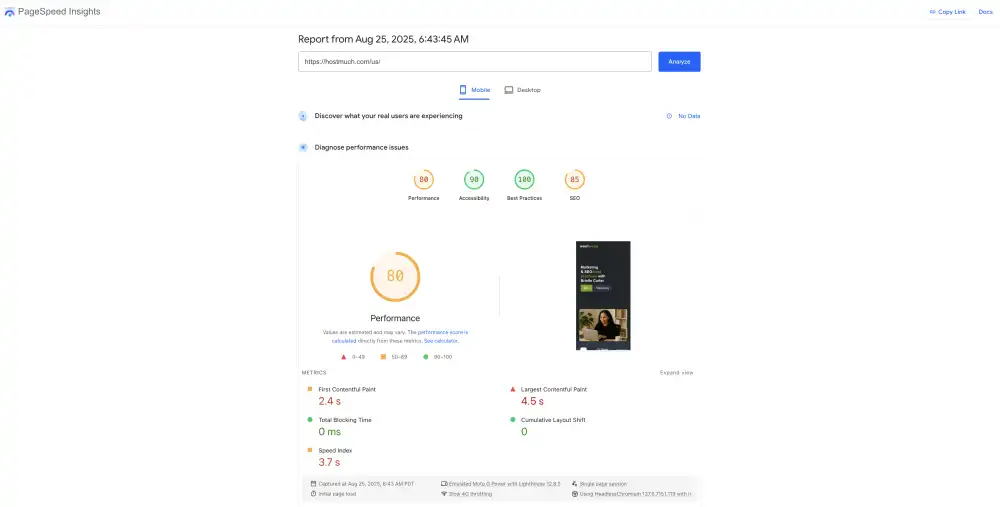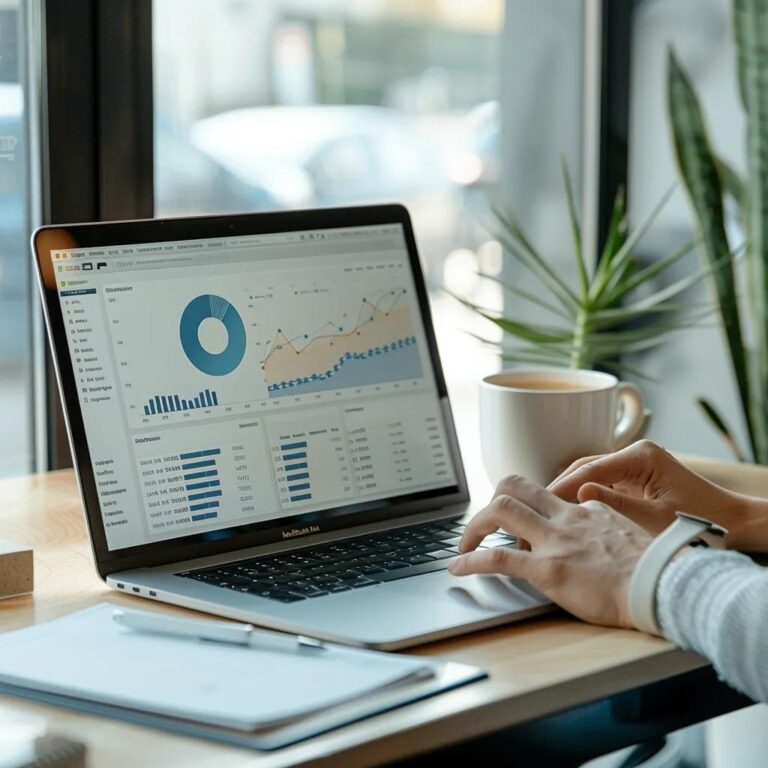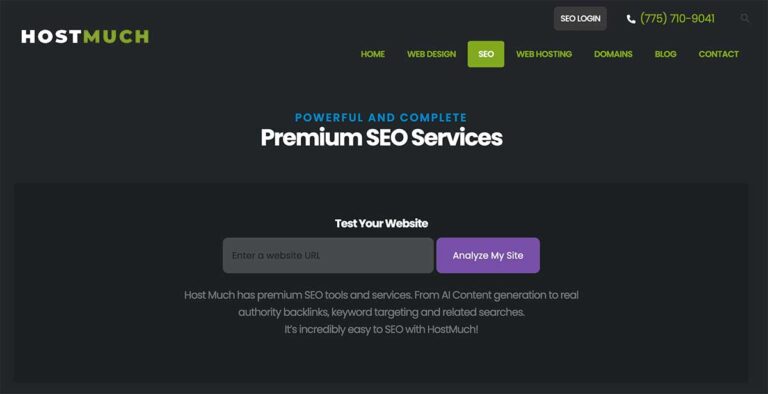Boost Organic Rankings with Proven SEO Strategies

How to Boost Organic Rankings with Proven SEO Strategies for Business Growth
Did you know that over 50 percent of website traffic originates from organic search? Focusing on proven SEO strategies can transform your visibility and revenue by driving qualified visitors without paid ads. In this guide, you’ll discover how targeted keyword research, on-page optimization, authority-building backlinks, technical SEO, content marketing and local tactics work together to elevate your rankings. We’ll also explore the tools needed, performance metrics to track, and how HostMuch’s integrated digital services—from web design to hosting and ongoing web management—amplify each strategy. Read on for an actionable roadmap that turns search traffic into loyal clients.
What Are the Most Effective SEO Strategies to Boost Organic Rankings?
Effective SEO strategies boost organic rankings by aligning content relevance, site authority and technical performance with searcher intent. The core approaches include:
- Keyword Research – Identifies high-value queries that attract your ideal audience.
- On-Page SEO – Optimizes titles, headings, URLs and multimedia to improve crawlability and relevance.
- Link Building – Acquires quality backlinks to signal authority and trustworthiness.
- Technical SEO – Ensures site speed, mobile responsiveness and crawlability meet modern standards.
- Content Marketing – Creates engaging assets that satisfy intent and foster shares and links.
- Local SEO – Targets geographic queries to capture nearby customers and enhance local visibility.
Harnessing these tactics in concert delivers measurable ranking gains and sustained traffic growth. To see how these strategies fit into a cohesive service offering, explore our SEO services that integrate each component into a unified plan.
How Does Keyword Research Drive Organic Growth?

Understanding the Foundation of Organic Growth
Organic growth refers to the increase in website traffic, brand visibility, and conversions through non-paid strategies such as search engine optimization (SEO). At the heart of this strategy lies keyword research. By identifying and targeting the words and phrases that potential customers are actively searching for, businesses can align their content with real demand. This alignment ensures search engines view the website as relevant, trustworthy, and authoritative within its niche.
Aligning Content With Search Intent
Every search query reflects a user’s intent. Some people are seeking information, while others are looking to make a purchase. Keyword research helps decode these intentions and ensures your content delivers exactly what your audience needs. Informational keywords build awareness, while transactional keywords capture high-value buyers. By mapping intent, businesses can strategically create a content funnel that drives both traffic and conversions.
Building Topical Authority Through Strategic Clusters
Search engines reward websites that demonstrate expertise and depth on specific subjects. Keyword research uncovers related terms, questions, and semantic variations that can be grouped into topic clusters. For example, a coffee equipment retailer might build a cluster around “fluid bed coffee roasters” by covering supporting topics like roasting profiles, maintenance guides, and green coffee sourcing. Each page strengthens the other, creating an interlinked ecosystem that signals authority and improves rankings across the board.
Targeting Low-Hanging Fruit for Quick Wins
Not all keywords are equal in terms of difficulty. Some highly competitive terms may take months or years to rank for, while long-tail keywords with lower search volumes can generate quicker results. Through keyword research tools and competitive analysis, businesses can identify low-hanging fruit—terms with attainable difficulty and sufficient volume. These opportunities deliver early wins that build momentum for larger growth initiatives.
Maximizing ROI With Commercial Keywords
Organic traffic is only valuable if it contributes to business outcomes. Keyword research identifies high commercial intent terms that correlate with revenue. For example, “buy Valenta 12 coffee roaster” has a direct purchase intent compared to “what is a coffee roaster.” By balancing awareness-driven content with conversion-focused keywords, businesses can maximize ROI from their SEO investment.
Enhancing User Engagement and Dwell Time
When content closely matches the searcher’s query, visitors are more likely to stay longer, engage with the page, and explore other areas of the site. Search engines interpret these behaviors as signals of quality and relevance. Keyword-driven content ensures the site answers real questions, which improves engagement metrics and, in turn, boosts rankings.
Strengthening Internal Linking and Site Architecture
Keyword research provides insights into how content should be organized. By using identified keywords as anchors, businesses can create a clear internal linking structure that guides both users and search engines through the website. This not only distributes authority across pages but also creates a logical user journey that supports conversions.
Driving Long-Term Sustainability
Paid advertising provides immediate visibility, but the traffic disappears as soon as the budget ends. Organic growth through keyword research compounds over time. A single well-optimized article can attract thousands of visitors for years with minimal ongoing investment. As businesses expand their keyword coverage, the compounding effect strengthens brand visibility, authority, and inbound lead generation.
Adapting to Market and Algorithm Changes
Search trends evolve as industries shift and consumer behavior changes. Keyword research is not a one-time activity but a continuous process. By monitoring emerging terms, businesses can stay ahead of competitors, adapt content strategies, and capture early attention in new markets. This adaptability ensures long-term relevance and resilience in organic search.
What Improves Website Rankings?

On-page SEO optimizes individual pages to rank for target terms by refining their structure, relevance and usability. Core elements include:
Properly optimized pages communicate clarity to search engines and users alike. Combining these practices with responsive web design ensures content loads quickly and displays flawlessly, supporting higher engagement and better rankings.
Crafting Optimized Title Tags
The title tag is one of the strongest on-page SEO elements. It should include the primary keyword near the beginning and stay within 50–60 characters to avoid truncation in search results. Clear, descriptive titles increase click-through rates by showing users exactly what to expect. Avoid keyword stuffing; instead, use natural phrasing that balances relevance and readability.
Writing Compelling Meta Descriptions
Although meta descriptions are not direct ranking factors, they influence how often users click through to your site. A well-written description summarizes the content in 150–160 characters, includes the target keyword, and entices users to engage. Think of it as a mini-advertisement for your page.
Using Header Tags for Structure and Clarity
Headings (H1, H2, H3, and so on) help organize your content while signaling importance to search engines. The H1 should contain the primary keyword and represent the main topic of the page. Subheadings should use variations of target keywords and provide logical divisions in the content. Proper use of header tags improves both SEO and user experience by making content scannable.
Optimizing Content for Relevance and Depth
High-quality content remains the foundation of on-page SEO. Content should:
- Cover topics comprehensively using keyword variations and related terms.
- Answer common questions that users might search.
- Use a natural, engaging tone that encourages time on page.
Google’s algorithm prioritizes pages that demonstrate expertise, authoritativeness, and trustworthiness (E-A-T). Well-researched, original content that provides unique insights strengthens these signals.
Implementing Keyword Placement Strategically
Keywords should appear in critical areas, such as:
- Title tag
- H1 heading
- First 100 words of content
- Subheadings
- URL slug
- Image alt attributes
However, keyword usage must feel natural. Over-optimization can lead to penalties, while balanced integration enhances contextual relevance.
Creating SEO-Friendly URLs
Short, descriptive URLs with primary keywords improve rankings and click-through rates. A clean URL like “/on-page-seo-best-practices” is far more effective than “/article?id=12345.” Avoid unnecessary words, symbols, or numbers that do not add value.
Optimizing Images and Multimedia
Images enhance user experience but can slow down site performance if not optimized. Best practices include:
- Compressing files to reduce load times.
- Using descriptive filenames with keywords.
- Adding alt text to improve accessibility and provide SEO signals.
- Implementing next-gen formats like WebP for efficiency.
Videos and interactive elements should also be optimized with transcripts, schema markup, and lazy loading.
Enhancing Internal Linking
Internal links distribute authority throughout the website and guide users to related content. Best practices include linking relevant keywords to deeper pages and maintaining a logical structure that encourages exploration. Each link should feel natural and provide value rather than appearing forced.
Prioritizing Page Speed and Core Web Vitals
Search engines now consider user experience metrics like page speed, interactivity, and visual stability. To meet Core Web Vitals benchmarks:
- Minify CSS and JavaScript.
- Leverage browser caching.
- Use a content delivery network (CDN).
- Ensure images and videos load quickly on mobile devices.
A fast-loading site increases engagement and supports higher rankings.
Optimizing for Mobile Responsiveness
With most searches occurring on mobile devices, mobile-first indexing has become the standard. Pages must adapt seamlessly to different screen sizes, ensuring that content, images, and navigation remain user-friendly across devices.
Leveraging Schema Markup
Structured data markup helps search engines better understand your content. By implementing schema, pages become eligible for rich results such as star ratings, FAQs, and event listings. These enhancements improve visibility and click-through rates.
Monitoring and Updating Content
On-page SEO is an ongoing process. Content should be audited regularly to ensure accuracy, relevance, and competitiveness. Updating outdated statistics, improving readability, and expanding sections with new insights all signal freshness to search engines.
How Do Link Building Strategies Enhance Website Authority?

Backlinks function as endorsements from other sites, improving your domain authority and trust in the eyes of search engines. High-quality link acquisition methods include:
- Guest Posting on authoritative industry blogs with contextual anchor text.
- Broken Link Building by replacing dead backlinks on third-party sites with your relevant resource.
- Resource Outreach to websites curating link directories, providing a linkable asset.
- Strategic Partnerships with complementary businesses for mutual linking opportunities.
Implementing a diversified backlink portfolio signals credibility and relevance, driving faster indexation and higher ranking potential.
Link Building Strategies and Domain Authority
Why Link Building Matters
Link building is one of the most critical aspects of search engine optimization (SEO). Search engines view backlinks—links from other websites pointing to yours—as signals of trust and credibility. When authoritative websites link to your content, it demonstrates that your site provides value worth referencing. This process strengthens your domain authority, which is a measure of how likely your website is to rank well in search results.
Understanding Domain Authority
Domain authority (DA) is a predictive metric developed by Moz, ranging from 1 to 100, that estimates how well a domain can rank. Higher scores indicate a stronger ability to perform in search engines. Although not a direct Google ranking factor, DA reflects the strength of a website’s backlink profile, relevance, and trustworthiness. Effective link building strategies help raise this score, leading to greater visibility and organic traffic.
Creating High-Value Content That Attracts Links
The foundation of any successful link building strategy is content worth linking to. Evergreen resources, detailed guides, original research, and infographics naturally attract backlinks. When your content provides unique insights or solves specific problems, industry peers are more likely to reference it. High-value content positions your site as an authority and magnetizes organic links without constant outreach.
Guest Posting on Authoritative Websites
Contributing guest articles to reputable blogs and industry publications is a proven link building tactic. By offering high-quality, relevant content, you earn backlinks within author bios or naturally in the article itself. The key is targeting publications that align with your niche and maintain strong domain authority. Guest posting not only generates links but also increases brand exposure and referral traffic.
Building Relationships With Industry Influencers
Relationships drive long-term link building success. Networking with influencers, journalists, and thought leaders creates opportunities for collaboration and backlinks. Engaging with their content, offering expert commentary, or co-authoring pieces can lead to natural mentions. Relationship-driven links carry more weight than transactional exchanges, as they emerge from authentic industry connections.
Leveraging Broken Link Building
Broken link building involves identifying dead links on other websites and offering your content as a replacement. Site owners benefit from fixing broken links, while you gain a valuable backlink. This approach requires research tools to find broken links and outreach to suggest your resource as a suitable substitute. Done at scale, it can be a powerful way to earn high-quality backlinks.
Resource Page and Directory Links
Many websites maintain resource pages or directories that list helpful tools, guides, and references. By suggesting your content or website for inclusion, you can earn backlinks that are both relevant and valuable. The key is ensuring your content genuinely adds value to the list and aligns with the page’s purpose.
Digital PR and Linkable Assets
Digital PR combines content marketing with outreach to earn coverage from media outlets and blogs. Linkable assets such as industry studies, surveys, or data visualizations are especially effective. When promoted through press releases or journalist networks, these resources can generate a surge of high-authority backlinks that significantly boost domain authority.
Local Link Building for Regional Authority
For businesses serving local markets, local link building strategies strengthen both SEO and community presence. Partnering with chambers of commerce, sponsoring community events, or collaborating with local organizations often results in backlinks from authoritative regional websites. These local signals improve visibility in geographic-based searches.
Monitoring Competitor Backlinks
Competitor analysis reveals opportunities for building links from sources that already trust others in your niche. By examining their backlink profiles, you can identify websites open to linking and reach out with your own content. This strategy helps level the playing field and uncover link opportunities you might not have considered.
Avoiding Black-Hat Tactics
Not all backlinks are beneficial. Buying links, participating in link farms, or using automated tools to generate links can lead to penalties from search engines. Sustainable growth comes from white-hat strategies—earning links through value and relationships. A smaller number of high-quality backlinks outweighs a large volume of low-quality ones.
Tracking and Measuring Link Building Success
Measuring the impact of link building requires consistent monitoring. Tools like Moz, Ahrefs, and SEMrush track new backlinks, evaluate their quality, and estimate domain authority growth. Beyond metrics, it’s important to measure the effect on organic traffic, keyword rankings, and conversions. A data-driven approach ensures continuous improvement in link building campaigns.
Next, we’ll examine the technical factors that underpin these efforts.
Why Is Technical SEO Essential for Organic Ranking Success?
Technical SEO strengthens the foundation of your website by improving performance, security and discoverability. Key areas include site speed, mobile-first responsiveness, crawl control and secure protocols. Addressing these factors ensures that search engines can efficiently crawl and index your content, while users enjoy a seamless experience—both critical signals for ranking algorithms. Employing reliable web hosting with optimized infrastructure further amplifies these benefits.
How Does Content Marketing Sustain Long-Term Organic Traffic?
Content marketing fuels organic growth by consistently delivering valuable, shareable assets that align with user intent and brand goals. Effective content types include:
- In-Depth Blog Posts that answer complex queries.
- Visual Infographics summarizing data and processes.
- Video Tutorials optimizing for platforms like YouTube.
- Interactive Tools such as calculators or quizzes.
Maintaining freshness through regular updates and repurposing ensures ongoing relevance. Integrating content creation with proactive web management keeps your site current, healthy and authoritative, leading to sustained traffic and engagement.
How Can Businesses Perform Keyword Research to Target the Right Audience?
Targeted keyword research identifies phrases that match your audience’s needs and business objectives by evaluating intent, volume and competitiveness. A systematic approach reveals under-served queries and high-conversion opportunities. Starting with seed terms, you expand into related questions, long-tail variations and semantic clusters. The outcome is a prioritized keyword list that informs page structure, content themes and link acquisition tactics, ensuring every piece of content contributes to ranking growth.
What Are Long-Tail Keywords and Why Do They Matter?
Long-tail keywords are extended search phrases—typically three or more words—that capture specific intent and lower competition. They matter because they:
- Attract highly targeted visitors ready to convert.
- Offer better cost-per-lead efficiency compared to broad terms.
- Improve topical relevance by addressing niche queries.
Focusing on long-tail variations unlocks incremental traffic and boosts authority on precise subjects before tackling head terms.
Which Tools Help Identify High-Impact Keywords?
These tools integrate search volume, difficulty metrics and SERP features to guide your content and link strategies. Using multiple data sources ensures a balanced view of keyword potential.
How to Analyze Keyword Difficulty and Search Volume Effectively?
Analyzing difficulty and volume involves balancing effort with opportunity. Prioritize keywords with moderate difficulty and sufficient volume that align with your domain authority. Calculate effort by assessing competitor strength and SERP features on target keywords. Pair volume metrics with conversion intent to select terms that not only drive visits but also link to revenue-generating pages.
How Does Understanding Search Intent Improve SEO Results?
Search intent classification—informational, navigational, transactional and commercial investigation—ensures your content matches what users seek. Aligning page structure and calls to action with intent enhances user satisfaction and reduces bounce rates. For example, a transactional keyword such as “buy web hosting plan” should lead to a product page, whereas an informational query like “how to improve site speed” benefits from a detailed guide.
What Are the Key On-Page SEO Techniques to Optimize Website Content?
On-page SEO techniques refine page elements to improve rankings and user engagement. They encompass metadata, internal linking, multimedia optimization and user experience signals. Applying these best practices increases relevance, boosts click-through rates and encourages deeper site exploration.
How to Optimize Title Tags, Meta Descriptions, and Header Tags?
- Place primary keywords at the beginning of title tags (50–60 characters).
- Craft meta descriptions (150–160 characters) that summarize page value and include a call to action.
- Structure headers hierarchically (H1 for main topic, H2/H3 for subtopics) to clarify content flow.
This layered approach enhances snippet appeal and supports featured-snippet eligibility by clearly defining content sections.
Why Is Internal Linking Important for SEO?
Internal links distribute authority across your site and establish topical relationships between pages. By using descriptive anchor text—such as “comprehensive SEO audit service”—you signal relevance and enable crawlers to discover related content more efficiently. A strategic internal linking framework increases time on site and strengthens semantic clusters.
How to Use Image Alt Text and URL Structure for Better Rankings?
- Writing descriptive image alt text that includes relevant entities (e.g., “keyword-research-organic-rankings-flowchart.png”).
- Creating concise, hyphenated URLs reflecting the page topic.
These actions improve accessibility, semantic clarity and ranking opportunities for visual search and rich results.
What Role Does User Experience Play in On-Page SEO?
User experience (UX) impacts dwell time, bounce rates and conversion metrics—key behavioral signals for search engines. A well-designed layout, clear navigation and mobile responsiveness keep visitors engaged. Merging UX insights with content structure ensures that pages satisfy intent and guide users toward desired actions.
Which Link Building Strategies Are Proven to Boost Organic Rankings?
Proven link building increases domain authority and ranking potential by earning high-quality, relevant backlinks. The most effective methods combine outreach, partnerships and content promotion to acquire links that signal trust and expertise.
How Do Backlinks Influence Domain Authority and Rankings?
Backlinks serve as votes of confidence, with each link from a reputable site enhancing your domain’s perceived authority. Search engines factor link quality, relevance and anchor text diversity into ranking algorithms. A strong backlink profile correlates with higher positions and greater click-through rates.
What Are Effective Methods for Acquiring High-Quality Backlinks?
- Guest Contributions: Publish expert articles on industry publications.
- Broken Link Reclamation: Replace dead links on authoritative sites with your resource.
- Resource Link Building: Create linkable assets (e.g., tools, original research) that attract references.
- Community Engagement: Participate in niche forums and associations to earn natural links.
These tactics diversify your link profile and maintain a steady flow of authority signals.
How to Analyze Competitor Backlink Profiles for SEO Advantage?
Competitive backlink analysis reveals linking opportunities by examining the sources and strategies of top rivals. Use tools like Ahrefs or Semrush to map referring domains, anchor text and link velocity. Replicating high-value patterns while targeting overlooked niches accelerates your authority growth.
What Are Common Link Building Mistakes to Avoid?
- Relying solely on low-quality directories or forums.
- Over-optimizing anchor text with exact-match keywords.
- Ignoring the relevance and authority of linking domains.
Steering clear of these mistakes protects your site from algorithmic penalties and preserves link equity.
How Does Technical SEO Improve Website Performance and Ranking?

Technical SEO optimizes infrastructure, security and indexing to ensure search engines can access and interpret your content. Addressing site health fundamentals lays the groundwork for all other optimizations.
What Are Core Web Vitals and Why Are They Important?
Core Web Vitals—LCP (Largest Contentful Paint), FID (First Input Delay) and CLS (Cumulative Layout Shift)—measure user experience metrics that Google uses as ranking signals. Improving these metrics enhances load speed, interactivity and visual stability, leading to higher user satisfaction and better organic placement.
How to Ensure Mobile-Friendliness for Google’s Mobile-First Indexing?
With mobile-first indexing, Google primarily evaluates your mobile version for ranking. Implement responsive design, optimize images and streamline code to deliver consistent performance across devices. Mobile usability improvements reduce bounce rates and reinforce search visibility.
How Do Sitemaps and Files Affect Crawlability?
XML sitemaps guide crawlers to your essential pages, while controls which sections to index. Properly configured crawl directives prevent low-value or duplicate content from being indexed, focusing search engine attention on high-impact assets.
Why Is SSL Security Critical for SEO?
HTTPS encryption via SSL boosts user trust and is a lightweight ranking factor. Securing your site with valid certificates prevents warning messages, protects data integrity and reinforces authority signals to search engines.
How Can Content Marketing Support Sustainable Organic Traffic Growth?
Content marketing sustains long-term rankings by delivering value, building trust and earning natural backlinks. A strategic content mix addresses every stage of the buyer journey, from awareness to purchase, reinforcing brand authority and encouraging repeat visits.
What Types of Content Drive Engagement and SEO Success?
- Educational Blog Posts that solve complex problems.
- Infographics illustrating data with visual appeal.
- Video Tutorials optimized for both YouTube and on-page playback.
- Case Studies showcasing real-world results.
How to Maintain Content Freshness and Relevance?
Regularly audit and update existing assets to reflect new data, trends and algorithm changes. Repurpose high-traffic pages into new formats, such as webinars or whitepapers, to extend their lifecycle and recapture search interest.
How Does User Engagement Influence Organic Rankings?
Behavioral metrics—time on page, scroll depth and repeat visits—signal content relevance and quality. Engaging formats, clear calls to action and intuitive navigation foster deeper interactions that boost these signals and reinforce ranking momentum.
What Role Does Video SEO Play in Organic Visibility?
Optimizing video content includes crafting descriptive titles, adding transcript text and creating engaging thumbnails. Hosting on YouTube expands discovery, while embedding videos on your site increases dwell time and enriches page semantics.
What Local SEO Tactics Help Small Businesses Boost Organic Rankings?
Local SEO drives targeted visibility for nearby customers by optimizing profiles, citations and geo-targeted content. These tactics strengthen local authority and connect you directly with searchers ready to buy.
How to Optimize Google Business Profile for Local Search?
Claiming and verifying your Google Business Profile ensures accurate listing details, service categories and business hours. Regularly publishing posts, responding to Q&A and adding photos keeps your profile active, improving local pack placement.
Why Are Local Citations and Reviews Important?
Consistent mentions of your name, address and phone number (NAP) across directories reinforce your local credibility. Positive reviews on Google and industry platforms drive click-through rates and strengthen trust signals.
How to Use Geo-Targeted Keywords Effectively?
Incorporate location modifiers—city, neighborhood or region—into titles, headings and page content. Targeting phrases like “Dallas web hosting solutions” captures searchers seeking nearby services and improves map pack rankings.
What Are Best Practices for Local Link Building?
Engage with community organizations, sponsor local events and partner with nearby businesses to earn authoritative local backlinks. These contextually relevant links support your geographic relevance and boost organic visibility in local searches.
What Are Common Questions About Improving Organic Rankings?
Businesses frequently wonder about timelines, tool selection and budget allocation when pursuing organic growth. Typical concerns include how soon rankings improve, the difference between organic and paid search, realistic time-frames for results, and top tools for monitoring performance. Addressing these themes helps set expectations and guides strategic planning, ensuring that your SEO roadmap aligns with both short-term wins and long-term objectives.
How Does HostMuch SEO Boost Organic Rankings for Businesses?
Our SEO service accelerates organic growth by combining expert strategy, integrated digital services and ongoing performance management. Our end-to-end approach ensures every SEO component works together to maximize visibility and conversion.
What Comprehensive SEO Solutions Does HostMuch Offer?
HostMuch provides a full suite of services including keyword research, on-page optimization, link building, technical audits and content marketing. Each service is tailored to your industry and business goals, ensuring a bespoke strategy that targets the highest-value opportunities.
How Does HostMuch Integrate SEO with Web Design and Hosting?
Seamless collaboration between our web design and web hosting teams guarantees that your site’s structure, speed and user experience support SEO objectives from the ground up. Responsive layouts, optimized images and secure, high-performance servers combine to deliver technical and experiential advantages.
What Case Studies Demonstrate HostMuch SEO Success?
Our portfolio includes projects such as doubling organic traffic for a local e-commerce retailer and achieving top-3 rankings for a regional service provider within six months. Each case highlights entity-rich strategies—targeted keywords, authoritative backlink campaigns and technical enhancements—that drove measurable ROI. Please view our SEO software page for an in-depth case study.
How to Get Started with Our Proven SEO Strategies?
Begin by scheduling a free consultation through our main portal at HostMuch. We’ll conduct an in-depth site audit, map your highest-impact keywords and outline a phased roadmap to boost your organic rankings. From domain selection to ongoing content management, technical analysis and authority building, we partner with you at every step to deliver frequent progress reports with lasting search success.






